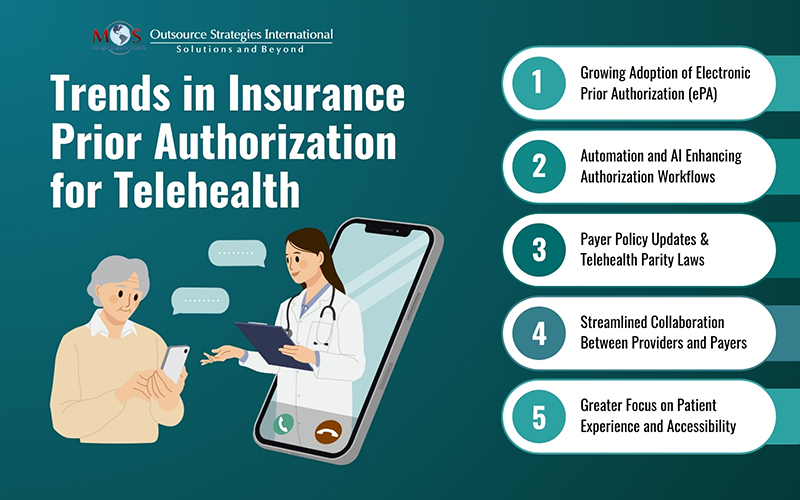The rapid growth of Telehealth has transformed the way patients access care and how healthcare providers deliver services. With conveniences ranging from virtual consultations to remote patient monitoring, telemedicine has become crucial in modern healthcare. As telemedicine continues to expand, one administrative process has gained increasing attention – insurance prior authorization in Telehealth. This process, while essential for ensuring medical necessity and cost control, has also become one of the most significant pain points for healthcare providers offering remote consultations. Having a clear understanding about the telehealth insurance prior authorization trends is essential for providers, payers, and healthcare administrators seeking to simplify operations and improve patient outcomes.
Streamline Your Telehealth Approvals Today
Learn How Automation Can Simplify Insurance Prior Authorization.
The Expanding Role of Prior Authorization in Telemedicine
Prior authorization in telemedicine refers to the approval process required by insurance companies before certain virtual healthcare services are rendered. Traditionally, prior authorization was designed to control costs, prevent unnecessary procedures, and ensure medical necessity. However, as telehealth became more prevalent, these processes had to adapt to new modes of care delivery.
Healthcare providers now face unique challenges when navigating telehealth insurance approvals. Unlike in-person services, virtual visits often involve evolving payer rules, changing CPT codes, and inconsistent authorization requirements across insurers. Many providers report delays and administrative burdens that can slow down the patient care cycle. Despite these challenges, there has been steady progress toward modernization, as insurers and healthcare systems recognize the need for more efficient and standardized prior authorization workflows.
Current Trends in Insurance Prior Authorization for Telehealth
- Increased Adoption of Electronic Prior Authorization (ePA) Systems – One of the most notable current trends in insurance prior authorization for telehealth is the adoption of electronic prior authorization, or ePA.
This digital process allows providers to submit, track, and receive prior authorization decisions through automated electronic systems integrated with EHRs and payer portals. ePA not only reduces paperwork but also shortens the approval timeline for telehealth services. Many healthcare organizations are adopting these systems to minimize manual errors and improve transparency in payer-provider communication.
- Automation and AI Integration in Authorization Workflows – The role of automation in telehealth prior authorization is another key trend redefining the administrative landscape. Artificial intelligence (AI) and machine learning tools are now being leveraged to automate repetitive tasks such as data entry, eligibility verification, and claims tracking.
Automation helps identify authorization requirements instantly, flag incomplete information, and predict approval likelihood based on payer patterns. This not only accelerates the approval process but also ensures greater accuracy in documentation. Automation also benefits payers, who can analyze prior authorization data in real time to assess provider compliance and service utilization. For both sides, the ultimate outcome is improved operational efficiency and fewer claim denials related to missing or incorrect authorization details.
- Payer Policy Updates and Telehealth Parity Laws – The regulatory environment for telehealth insurance approvals continues to evolve as states and federal agencies update their telehealth parity laws.
These laws aim to ensure that telemedicine services are reimbursed at rates comparable to in-person visits. Consequently, payers are revising their authorization requirements and coverage policies to align with new legal frameworks. Providers must stay informed about these changes to ensure compliance and avoid unnecessary denials.
- Streamlined Provider-Payer Collaboration – To reduce administrative burden, payers and healthcare providers are increasingly collaborating to redesign the prior authorization process. This includes creating shared digital platforms for documentation, real-time status updates, and feedback mechanisms.
Such initiatives promote transparency, enabling both sides to manage authorization requests more efficiently. For telehealth practices, these collaborations can mean fewer disruptions to virtual care delivery and faster patient access to necessary treatments.
- Focus on Patient Experience – While insurance prior authorization is often seen as a payer-driven process, the patient experience is now becoming a focal point. Long approval times can delay telehealth appointments, discourage patients from seeking care, or lead to treatment abandonment.
To address this, healthcare providers are adopting patient-centric strategies – such as proactive communication about authorization requirements and integrating prior authorization updates into patient portals. These approaches enhance trust and transparency, which are critical to sustaining telehealth adoption in the long term.

Despite technological and procedural improvements, prior authorization in telemedicine still faces hurdles.
Some of the key challenges include –
- Lack of uniform standards – Each insurer has their own set of authorization requirements for telehealth, creating confusion among providers.
- Inconsistent code recognition – Some payers do not recognize newer telehealth CPT codes, leading to denied claims even after authorization.
- Administrative overload – Small and mid-sized practices often struggle with the time and staffing required to manage high volumes of authorizations.
- Delayed responses – Even with electronic systems, response times can vary significantly depending on the payer.
These challenges emphasize the need for continued innovation, regulatory support, and payer-provider alignment.
How Healthcare Providers Can Adapt to Emerging Authorization Trends
To navigate evolving insurance prior authorization trends in telehealth, healthcare organizations should adopt proactive strategies focused on efficiency, compliance, and technology integration –
- Invest in automation tools that integrate with your EHR and billing systems to streamline prior authorization workflows.
- Stay updated on payer policies and telehealth coverage rules to avoid claim denials.
- Train staff on telehealth-specific authorization requirements and documentation standards.
- Use predictive analytics to identify high-risk claims and authorization bottlenecks.
- Establish payer communication protocols for clarifying coverage before patient visits.
The Future of Insurance Prior Authorization in Telehealth
The future of insurance prior authorization is expected to be shaped by greater digitalization and regulatory reform. With the federal government pushing for interoperability and faster prior authorization turnaround times, many payers are investing in automated systems and standardized data exchange formats.
The integration of artificial intelligence will further reduce manual intervention, ensuring approvals are faster, more accurate, and less burdensome for both providers and patients. In short, the final goal is to strike a balance between cost control and patient access – allowing telehealth to flourish as a permanent, efficient, and equitable component of the healthcare ecosystem.
The evolution of insurance prior authorization within telehealth reflects a broader shift toward digital efficiency and patient-centered care. As prior authorization in telemedicine continues to modernize through automation, regulatory changes, and collaborative innovation, providers must remain well informed.
By embracing telehealth insurance approval technologies and staying updated with the role of automation in telehealth prior authorization, healthcare organizations can overcome administrative hurdles and deliver smooth virtual care experiences. Understanding and adapting to current trends in insurance prior authorization for telehealth is crucial for maintaining compliance, optimizing reimbursement, and ensuring patients continue to benefit from the convenience and accessibility that telemedicine provides.
Stay ahead of Telehealth Trends .
Explore solutions for faster, more efficient insurance prior authorization.




